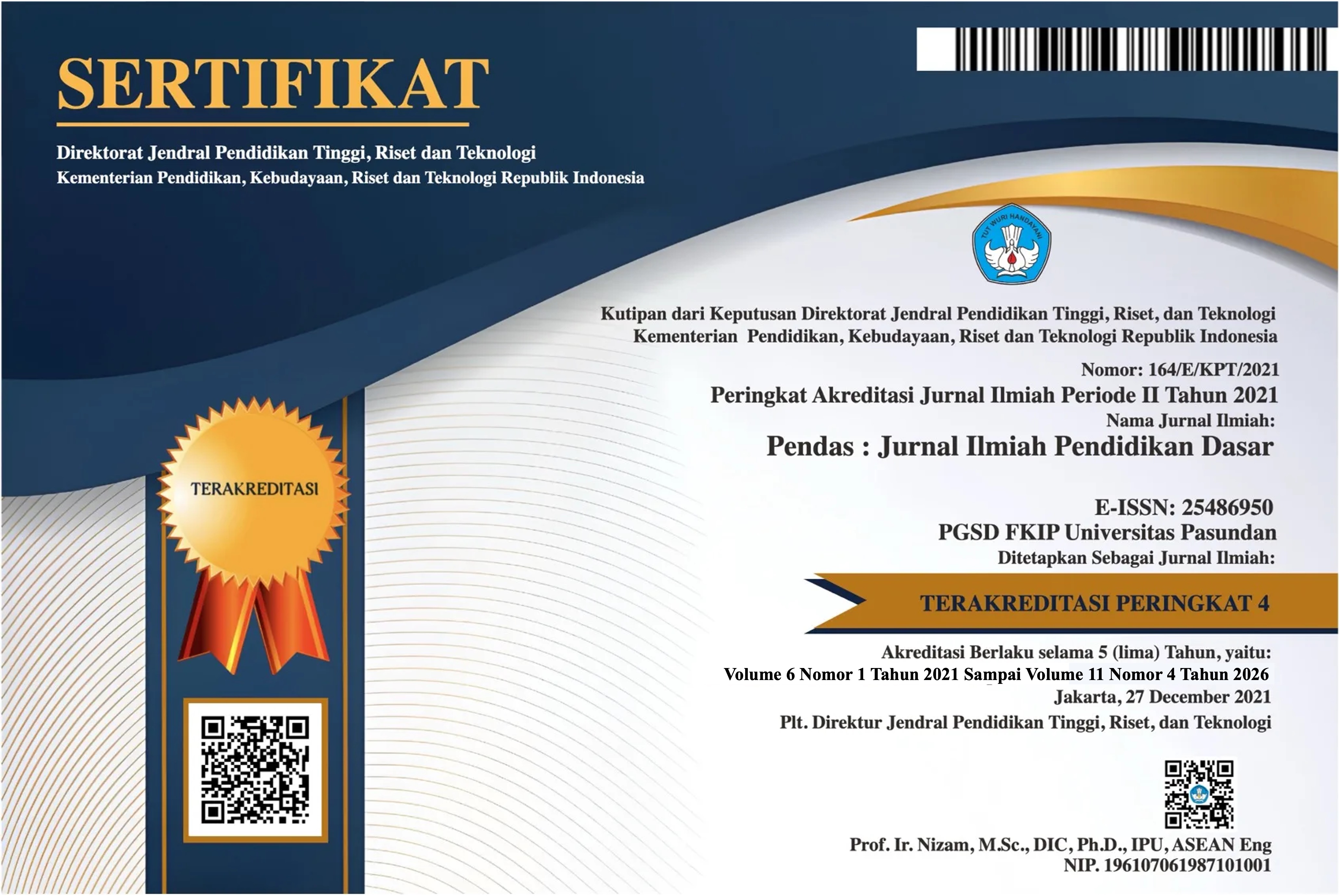PENGGUNAAN MEDIA GOOGLE EARTH UNTUK MENINGKATKAN MOTIVASI BELAJAR IPS DI SEKOLAH DASAR
DOI:
https://doi.org/10.23969/jp.v9i2.13554Keywords:
social studies learning, google earth, elementary schoolAbstract
Students' low learning motivation can be improved by using digital technology-based learning media such as Google Earth. This research aims to describe Google Earth in social studies learning to overcome students' boredom and introduce Google Earth as a world exploration tool. The method used in this research is a descriptive qualitative approach. The research will be carried out in the even semester of 2022/2023. The data collection techniques use interviews, observation and documentation. Interviews are aimed at educators and students. Observations were carried out to find out how social studies learning about ASEAN countries in class VI was implemented at SDN Ayah Kebumen. The findings before using Google Earth were that students were less interested in learning and easily felt bored so that the teaching and learning process was less than optimal. The results of the research show that after using Google Earth media students are more active in participating in learning and do not easily feel bored and increase student interest. The use of Google Earth learning media aims to increase student learning motivation and prevent boredom in the process of teaching and learning activities. So Google Earth deserves to be used as an alternative media to achieve effective learning.
Downloads
References
Arifin. (2019). Penelitian Pendidikan: Metode dan Paradigma baru. Remaja Rosda Karya.
Bahan, S., Nadziroh, N., & Chairiyah, C. (2021). Pengembangan media pakapin dalam pembelajaran tematik muatan PPkn pada siswa Kelas II SD Pangudi Luhur St. Aloysius Sedayu. TRIHAYU: Jurnal Pendidikan Ke-SD-An, 8(1). https://doi.org/10.30738/trihayu.v8i1.11134
Creswell, J. W. (2017). Resech Design: Qualitative, quantitative, and mixed methods approaches. Sage Publication.
Diana, M. W., & Chairiyah, C. (2021). Pengembangan media papan kartu bergambar pada pembelajaran tematik muatan PPkn siswa kelas II SD. TRIHAYU: Jurnal Pendidikan Ke-SDAn, 7(2), 1078–1087. https://doi.org/10.30738/trihayu.v7i2.9167
Goh, W., Ayub, E., Wong, S. Y., & Lim, C. L. (2017). The importance of teacher’s presence and engagement in MOOC learning environment: A case study. 2017 IEEE Conference on ELearning, e-Management and e-Services (IC3e), 127–132. https://doi.org/10.1109/IC3e.2017.8409250
Hamalik, O. (2014). Kurikulum dan Pembelajaran. Bumi Aksara. Hamzah, B. (2014). Assesment Pembelajaran. Bumi Aksara.
Harahap, N. (2020). Penelitian Kualitatif. Wal ashri Publishing. http://repository.uinsu.ac.id/9105/1/BUKU METODOLOGI PENELITIAN KUALITATIF DR. NURSAPIA HARAHAP, M.HUM.pdf
Magta, M. (2013). Konsep pendidikan Ki Hajar Dewantara pada anak usia dini. Jurnal Pendidikan Usia Dini, 7(2), 221–232. https://doi.org/https://doi.org/10.21009/JPUD.072.02
Munir. (2009). Pembelajaran Jarak Jauh Berbasis Teknologi Informasi dan Komunikasi. Bandung: Alfabeta
Putri, R. E., & Zuryanty. (2020). Peningkatan hasil belajar siswa sekolah dasar dalam pembelajaran tematik terpadu menggunakan model problem based learning. Journal of Basic Education Studies, 3(2), 54–62. https://ejurnalunsam.id/index.php/jbes/article/download/2671/2136.
Rifayanti, Z. E. T., & Salamah, E. R. (2019). Implementation of digital literacy in social sciences education elementary school with wayang media for STKIP Bina Insan Mandiri PGSD students. Social, Humanities, and Educational Studies (SHEs): Conference Series, 1(2), 533. https://doi.org/10.20961/shes.v1i2.26850
Sidiq, U., & Choiri, M. M. (2019). Metode penelitian kualitatif di bidang pendidikan. Journal of Chemical Information and Modeling, 53(9), 1–228. http://repository.iainponorogo.ac.id/484/1/METODE PENELITIAN KUALITATIF DI BIDANG PENDIDIKAN.pdf
Sulianto, J., & Yulianti, F. (2016). The implementation of hand-puppets as a storytelling media to the students’ language skills and characters (an R&D on the second grader of SDN 6 Karangasem Batang Central Java Indonesia). Proceeding of International Conference on Teacher Training and Education (ICTTE) FKIP UNS 2015, 161–164. https://jurnal.fkip.uns.ac.id/index.php/ictte/article/view/7576/5420
Suryana, S. (2020). Permasalahan mutu pendidikan dalam perspektif pembangunan pendidikan. Edukasi, 14(1). https://doi.org/10.15294/edukasi.v14i1.971
Syamsudin, A. (2015). Pengembangan Instrumen Evaluasi Non Tes (Informal) untuk Menjaring Data Kualitatif Perkembangan Anak Usia Dini. Jurnal Pendidikan Anak, 3(1). https://doi.org/10.21831/jpa.v3i1.2882
Tam, H., Kwok, S. Y. C. L., Hui, A. N. N., Chan, D. K., Leung, C., Leung, J., Lo, H., & Lai, S. (2021). The significance of emotional intelligence to students’ learning motivation and academic achievement: A study in Hong Kong with a Confucian heritage. Children and Youth Services Review, 121, 105847. https://doi.org/10.1016/j.childyouth.2020.105847
Trevino, N. N., & DeFreitas, S. C. (2014). The relationship between intrinsic motivation and academic achievement for first generation Latino college students. Social Psychology of Education, 17(2), 293–306. https://doi.org/10.1007/s11218-013-9245-3
Wahyuningtyas, R., & Sulasmono, B. S. (2020). Pentingnya media dalam pembelajaran guna meningkatkan hasil belajar di sekolah dasar. EDUKATIF : JURNAL ILMU PENDIDIKAN, 2(1), 23–27. https://doi.org/10.31004/edukatif.v2i1.77
Widodo, Rahmad. 2010. Media Google Earth. Yoyakarta: Andi Yogyakarta.
Yousman, Yeyep. 2008. Google Earth. Yogyakarta: Andi Yogyakarta
Downloads
Published
Issue
Section
License
Copyright (c) 2024 Pendas : Jurnal Ilmiah Pendidikan Dasar

This work is licensed under a Creative Commons Attribution 4.0 International License.



















